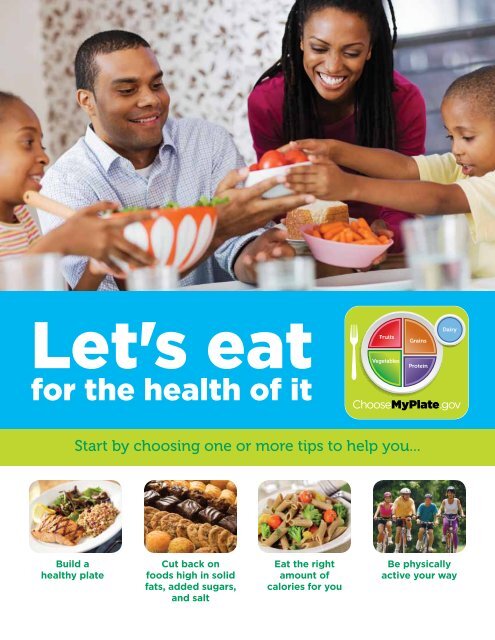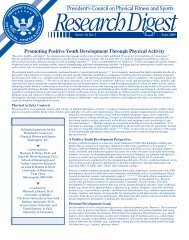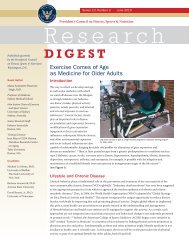Let's Eat for the Health of It - US Department of Agriculture
Let's Eat for the Health of It - US Department of Agriculture
Let's Eat for the Health of It - US Department of Agriculture
You also want an ePaper? Increase the reach of your titles
YUMPU automatically turns print PDFs into web optimized ePapers that Google loves.
<strong>Let's</strong> eat<br />
<strong>for</strong> <strong>the</strong> health <strong>of</strong> it<br />
Dairy<br />
Fruits<br />
Grains<br />
Vegetables<br />
Protein<br />
ChooseMyPlate.gov<br />
Start by choosing one or more tips to help you...<br />
Build a<br />
healthy plate<br />
Cut back on<br />
foods high in solid<br />
fats, added sugars,<br />
and salt<br />
<strong>Eat</strong> <strong>the</strong> right<br />
amount <strong>of</strong><br />
calories <strong>for</strong> you<br />
Be physically<br />
active your way
4Build a healthy plate<br />
Be<strong>for</strong>e you eat, think about what goes on your<br />
plate or in your cup or bowl. Foods like vegetables,<br />
fruits, whole grains, low-fat dairy products, and<br />
lean protein foods contain <strong>the</strong> nutrients you<br />
need without too many calories. Try some <strong>of</strong><br />
<strong>the</strong>se options.<br />
Make half your plate fruits and vegetables.<br />
• <strong>Eat</strong> red, orange, and dark-green vegetables, such as<br />
tomatoes, sweet potatoes, and broccoli, in main and<br />
side dishes.<br />
• <strong>Eat</strong> fruit, vegetables, or unsalted nuts as snacks—<strong>the</strong>y<br />
are nature’s original fast foods.<br />
Switch to skim or 1% milk.<br />
• They have <strong>the</strong> same amount <strong>of</strong><br />
calcium and o<strong>the</strong>r essential<br />
nutrients as whole milk, but less<br />
fat and calories.<br />
• Try calcium-<strong>for</strong>tified soy products<br />
as an alternative to dairy foods.<br />
Make at least half your<br />
grains whole.<br />
• Choose 100% wholegrain<br />
cereals, breads,<br />
crackers, rice, and pasta.<br />
• Check <strong>the</strong> ingredients<br />
list on food packages to<br />
find whole-grain foods.<br />
Vary your protein<br />
food choices.<br />
• Twice a week, make<br />
seafood <strong>the</strong> protein on<br />
your plate.<br />
• <strong>Eat</strong> beans, which are a<br />
natural source <strong>of</strong> fiber<br />
and protein.<br />
• Keep meat and poultry portions small and lean.<br />
Keep your food safe to eat—learn more at<br />
www.FoodSafety.gov.<br />
4Cut back on foods<br />
high in solid fats,<br />
added sugars, and salt<br />
Many people eat foods with too much solid fats,<br />
added sugars, and salt (sodium). Added sugars<br />
and fats load foods with extra calories you<br />
don’t need. Too much sodium may increase<br />
your blood pressure.<br />
Choose foods and drinks with little or no added sugars.<br />
• Drink water instead <strong>of</strong> sugary drinks. There are about<br />
10 packets <strong>of</strong> sugar in a 12-ounce can <strong>of</strong> soda.<br />
• Select fruit <strong>for</strong> dessert. <strong>Eat</strong> sugary desserts less <strong>of</strong>ten.<br />
• Choose 100% fruit juice instead <strong>of</strong> fruit-flavored drinks.<br />
Look out <strong>for</strong> salt (sodium) in foods you buy—<br />
it all adds up. <br />
• Compare sodium in foods like soup, bread, and frozen<br />
meals—and choose <strong>the</strong> foods with lower numbers.<br />
• Add spices or herbs to season food without<br />
adding salt.<br />
<strong>Eat</strong> fewer foods that are high in solid fats.<br />
• Make major sources <strong>of</strong> saturated fats—such<br />
as cakes, cookies, ice cream, pizza, cheese,<br />
sausages, and hot dogs—occasional choices,<br />
not everyday foods.<br />
• Select lean cuts <strong>of</strong> meats or poultry and fat-free<br />
or low-fat milk, yogurt, and cheese.<br />
• Switch from solid fats to oils when preparing food.*<br />
*Examples <strong>of</strong> solid fats and oils<br />
Solid Fats<br />
Beef, pork, and chicken fat<br />
Butter, cream, and milk fat<br />
Coconut, palm, and palm kernel oils<br />
Hydrogenated oil<br />
Partially hydrogenated oil<br />
Shortening<br />
Stick margarine<br />
Oils<br />
Canola oil<br />
Corn oil<br />
Cottonseed oil<br />
Olive oil<br />
Peanut oil<br />
Saffower oil<br />
Sunflower oil<br />
Tub (s<strong>of</strong>t) margarine<br />
Vegetable oil
4<strong>Eat</strong> <strong>the</strong> right amount <strong>of</strong> calories <strong>for</strong> you<br />
Everyone has a personal<br />
calorie limit. Staying<br />
within yours can help<br />
you get to or maintain<br />
a healthy weight. People<br />
who are successful at<br />
managing <strong>the</strong>ir weight<br />
have found ways to<br />
keep track <strong>of</strong> how much<br />
<strong>the</strong>y eat in a day, even<br />
if <strong>the</strong>y don’t count<br />
every calorie.<br />
Enjoy your food, but eat less.<br />
• Get your personal daily calorie limit at<br />
www.ChooseMyPlate.gov and keep that number<br />
in mind when deciding what to eat.<br />
• Think be<strong>for</strong>e you eat…is it worth <strong>the</strong> calories?<br />
• Avoid oversized portions.<br />
• Use a smaller plate, bowl, and glass.<br />
• Stop eating when you are satisfied, not full.<br />
Cook more <strong>of</strong>ten at home, where you are in control<br />
<strong>of</strong> what’s in your food.<br />
When eating<br />
out, choose<br />
lower calorie<br />
menu options.<br />
• Check posted<br />
calorie<br />
amounts.<br />
• Choose dishes<br />
that include<br />
vegetables,<br />
fruits, and/or<br />
whole grains.<br />
• Order a smaller portion or share when eating out.<br />
Write down what you eat to keep track <strong>of</strong> how much<br />
you eat.<br />
If you drink alcoholic beverages, do so sensibly—limit to<br />
1 drink a day <strong>for</strong> women or to 2 drinks a day <strong>for</strong> men.<br />
4Be physically active your way<br />
Pick activities that you like and start by doing<br />
what you can, at least 10 minutes at a time. Every<br />
bit adds up, and <strong>the</strong> health benefits increase as<br />
you spend more time being active.<br />
Note to parents<br />
What you eat and<br />
drink and your level<br />
<strong>of</strong> physical activity<br />
are important <strong>for</strong><br />
your own health,<br />
and also <strong>for</strong> your<br />
children's health.<br />
You are your children’s most important role model. Your<br />
children pay attention to what you do more than what<br />
you say.<br />
You can do a lot to help your children develop healthy<br />
habits <strong>for</strong> life by providing and eating healthy meals and<br />
snacks. For example, don’t just tell your children to eat<br />
<strong>the</strong>ir vegetables—show <strong>the</strong>m that you eat and enjoy<br />
vegetables every day.
U.S. <strong>Department</strong> <strong>of</strong> <strong>Agriculture</strong><br />
U.S. <strong>Department</strong> <strong>of</strong> <strong>Health</strong> and Human Services<br />
www.dietaryguidelines.gov<br />
Use food labels to help you make better choices<br />
Most packaged foods have a Nutrition Facts label and an ingredients<br />
list. For a healthier you, use this tool to make smart food choices<br />
quickly and easily.<br />
Check <strong>for</strong> calories. Be sure to look at <strong>the</strong> serving size and how many<br />
servings you are actually consuming. If you double <strong>the</strong> servings you<br />
eat, you double <strong>the</strong> calories.<br />
Choose foods with lower calories, saturated fat, trans fat, and sodium.<br />
Check <strong>for</strong> added sugars using <strong>the</strong> ingredients list. When a sugar<br />
is close to first on <strong>the</strong> ingredients list, <strong>the</strong> food is high in added<br />
sugars. Some names <strong>for</strong> added sugars include sucrose, glucose, high<br />
fructose corn syrup, corn syrup, maple syrup, and fructose.<br />
Dietary Guidelines <strong>for</strong> Americans<br />
Dietary Guidelines<br />
<strong>for</strong> Americans<br />
The Dietary Guidelines <strong>for</strong> Americans, 2010 are <strong>the</strong> best<br />
science-based advice on how to eat <strong>for</strong> health. The<br />
Guidelines encourage all Americans to eat a healthy diet<br />
and be physically active.<br />
Improving what you eat and being active will help to<br />
reduce your risk <strong>of</strong> chronic diseases such as diabetes, heart<br />
disease, some cancers, and obesity. Taking <strong>the</strong> steps in this<br />
brochure will help you follow <strong>the</strong> Guidelines.<br />
For more in<strong>for</strong>mation, go to:<br />
• www.DietaryGuidelines.gov<br />
• www.ChooseMyPlate.gov<br />
• www.<strong>Health</strong>.gov/paguidelines<br />
• www.<strong>Health</strong>Finder.gov<br />
<strong>US</strong>DA Publication number: Home and Garden Bulletin No. 232-CP<br />
HHS Publication number: HHS-ODPHP-2010-01-DGA-B<br />
June 2011<br />
The U.S. <strong>Department</strong>s <strong>of</strong> <strong>Agriculture</strong> and <strong>Health</strong> and Human Services are equal opportunity providers and employers.













